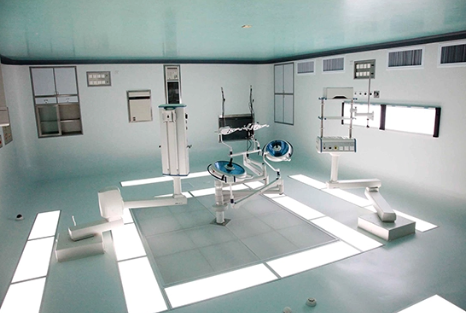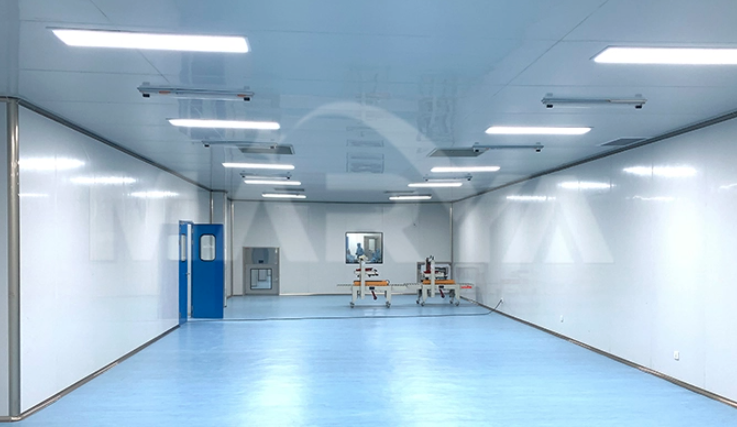Views: 0 Author: Site Editor Publish Time: 2025-08-13 Origin: Site






In today’s advanced industrial, pharmaceutical, and research environments, maintaining a contaminant-free workspace is essential. Cleanroom systems have become the backbone of industries where precision, safety, and compliance with strict quality standards are critical. Globally, millions of cleanrooms are installed, and the demand continues to grow with at least 8,000 new installations expected annually.
A cleanroom system ensures controlled environmental parameters, reducing airborne particles, microorganisms, and other contaminants. By maintaining optimal conditions of temperature, humidity, and airflow, these systems allow businesses to achieve high-quality outcomes without cross-contamination.
A cleanroom system is a controlled environment designed to minimize the presence of contaminants. These systems are essential in industries such as pharmaceuticals, biotechnology, medical devices, semiconductor manufacturing, and research laboratories.
The purpose of a cleanroom system is to:
Filter and control airborne particles.
Maintain precise temperature and humidity levels.
Control airflow patterns to prevent cross-contamination.
Enable sensitive operations to occur under consistent and safe conditions.
Modern cleanroom systems are often modular, allowing flexibility in design and operation.
| Component | Function | Notes |
|---|---|---|
| Air Filtration (HEPA/ULPA) | Removes dust, bacteria, and particles from air | HEPA filters remove 99.97% of particles ≥0.3 μm; ULPA filters remove 99.999% ≥0.12 μm |
| Temperature Control | Maintains optimal operational temperature | Critical for electronics, pharmaceutical storage, and experimental reproducibility |
| Humidity Control | Reduces condensation and static electricity | Low humidity reduces ESD risk, high humidity prevents desiccation of sensitive materials |
| Pressure Control | Positive/negative pressure prevents contamination ingress/egress | Positive pressure keeps contaminants out; negative pressure contains hazardous substances |
| Airflow Design | Unidirectional or non-unidirectional airflow | Directs particles away from critical areas and equipment |
| Environmental Control Area (ECA) | Subsection with precise air and environmental regulation | Can be static (no personnel) or dynamic (with personnel) |
A Cleanroom Environmental Control Area is a specialized section within a cleanroom where air is filtered and strictly controlled. ECAs are designed for sensitive operations where even minor contamination can compromise results.
Features of ECAs:
Recirculated air to reduce dependency on external sources.
Controlled temperature and humidity.
Positive or negative pressurization for particle management.
Can operate independently as static or dynamic zones.

Non-Unidirectional (Ventilated) Cleanrooms:
Air is mixed and recirculated.
Less expensive and suitable for moderate contamination control.
Unidirectional (Laminar Flow) Cleanrooms:
Air flows in a single, uniform direction, minimizing turbulence.
Ideal for high-precision applications like pharmaceuticals and microelectronics.
| Type | Description | Applications |
|---|---|---|
| Soft Wall | Lightweight, flexible, and modular | Temporary setups, moderate ISO classifications |
| Hard Wall / Rigid Modular | Solid, modular walls with high filtration compatibility | ISO 5–7 cleanrooms, long-term installations, high-precision industries |
HEPA (High-Efficiency Particulate Air) and ULPA (Ultra-Low Penetration Air) filters are the cornerstone of maintaining a contamination-free environment in cleanrooms. These filters are designed to capture particles as small as 0.12 μm, effectively removing dust, microbes, and other airborne contaminants. Air is continuously drawn through these filters, ensuring that the air circulating within the cleanroom is of the highest purity. The efficiency of these filters is critical, especially in industries like semiconductor manufacturing and pharmaceutical production, where even the slightest contamination can lead to significant defects or failures.
Air showers play a crucial role in preventing contaminants from entering the cleanroom. As personnel and equipment pass through air showers, high-velocity jets of filtered air remove loose particles from surfaces, clothing, and materials. This step is essential because it reduces the risk of introducing contaminants that could compromise the cleanroom environment. Air showers are typically installed at entry points and are equipped with sensors that activate the airflow when someone or something passes through.
Precise control over temperature and humidity is essential in cleanrooms to prevent issues such as static discharge, condensation, and material degradation. Temperature and humidity levels must be carefully managed to ensure optimal conditions for the specific processes being conducted. For example, in electronics and microfabrication, low humidity levels are critical to reduce static electricity, which can damage sensitive components. On the other hand, in biological and pharmaceutical applications, maintaining higher humidity levels is necessary to prevent desiccation of samples or products.
Sensors placed throughout the cleanroom provide real-time data on temperature and humidity levels, enabling continuous monitoring and adjustments. These sensors are connected to a centralized control system that can automatically regulate the environment to maintain the desired conditions. Advanced cleanroom systems may also include predictive analytics and machine learning algorithms to anticipate potential deviations and make proactive adjustments, ensuring that the environment remains stable and consistent.
Low Humidity Control: In industries like electronics and semiconductor manufacturing, maintaining low humidity levels (typically around 30-50% relative humidity) is crucial. Low humidity reduces the risk of static electricity buildup, which can attract and hold contaminants and potentially damage sensitive electronic components. Additionally, low humidity helps prevent corrosion and other moisture-related issues that can affect the performance and reliability of electronic devices.
High Humidity Control: In contrast, high humidity levels (often around 50-70% relative humidity) are necessary in applications involving biological samples, pharmaceutical products, and certain chemical processes. High humidity prevents desiccation, which can degrade the quality and integrity of biological materials or pharmaceutical formulations. It also helps maintain the stability of certain chemical reactions and processes that are sensitive to moisture levels.
Cleanrooms utilize differential pressure to control the movement of particles and maintain a controlled environment. The type of pressure control used depends on the specific requirements and applications of the cleanroom.
Positive Pressure: Positive pressure cleanrooms are designed to keep contaminants out. The air pressure inside the cleanroom is maintained at a higher level than the surrounding environment, ensuring that any leaks or openings result in air flowing outwards rather than inwards. This is particularly important in industries like pharmaceutical production, where maintaining a sterile environment is critical to prevent contamination of products. Positive pressure also helps protect sensitive processes from external airborne contaminants, ensuring that the cleanroom remains in compliance with stringent cleanliness standards.
Negative Pressure: Negative pressure cleanrooms, on the other hand, are designed to contain hazardous substances. The air pressure inside the cleanroom is maintained at a lower level than the surrounding environment, ensuring that any leaks or openings result in air flowing inwards rather than outwards. This is essential in laboratories dealing with biohazards, chemical contaminants, or radioactive materials, where the primary goal is to prevent the escape of harmful substances into the surrounding environment. Negative pressure cleanrooms are equipped with specialized ventilation systems that continuously exhaust air to maintain the pressure differential and ensure that hazardous materials are safely contained.
Cleanroom systems rely on continuous monitoring to maintain high standards.
Viable particles: Living microorganisms (bacteria, fungi).
Non-viable particles: Dust, skin cells, fibers.
Monitoring devices: optical particle counters, condensation particle counters.
Air Sampling: Active (pumps and impactors) and passive (settle plates).
Surface Sampling: Contact plates pressed on surfaces, then incubated for microbial growth.
Airflow velocity measured by anemometers.
Differential pressure ensures correct air movement and containment.

The first step in selecting a cleanroom system is to identify the specific requirements of your operations. Different industries and processes have varying needs when it comes to cleanliness levels and environmental control. For example, a pharmaceutical manufacturing facility may require a higher level of air filtration and contamination control compared to a general electronics assembly plant. Understanding the nature of your work, such as the sensitivity of the materials being handled or the precision of the processes involved, will help you determine whether you need a modular cleanroom, a softwall cleanroom, or a hardwall cleanroom. Modular cleanrooms offer flexibility and ease of installation, making them suitable for temporary setups or when space is limited.
Compliance with international standards such as ISO (International Organization for Standardization) and FED (Federal Standard 209E) is not just a recommendation but a necessity for many industries. These standards define the acceptable levels of airborne particulates and other contaminants in a cleanroom environment. For instance, an ISO Class 5 cleanroom has a maximum allowable number of particles per cubic meter, and maintaining this level is critical for processes like semiconductor manufacturing or sterile medical device production. Failure to meet these standards can result in product defects, regulatory penalties, and damage to your company’s reputation. Therefore, it is essential to ensure that your cleanroom system is designed, installed, and operated in accordance with the relevant ISO/FED classifications.
Another important consideration is the type of environmental control system (ECA) you need. Static and dynamic ECAs serve different purposes and are suitable for different scenarios based on personnel requirements and operational dynamics. Static ECAs are designed to maintain a constant and stable environment within the cleanroom, regardless of external factors. They are ideal for applications where the processes are relatively consistent and do not require frequent adjustments to temperature, humidity, or pressure. This type of system is often used in research laboratories or quality control facilities where precision and repeatability are key. Dynamic ECAs, on the other hand, are more flexible and can adapt to changing conditions in real - time.
Given the complexity and critical nature of cleanroom systems, it is highly advisable to consult experts in the field. These professionals have the knowledge and experience to guide you through the entire process, from initial design and layout to installation and ongoing maintenance. During the design phase, they can help you optimize the cleanroom configuration to maximize efficiency and minimize contamination risks. They can also advise you on the best materials and components to use, taking into account factors such as durability, ease of cleaning, and compatibility with your specific processes. Proper installation is equally important, as any errors or oversights can compromise the performance of the cleanroom system. Experts will ensure that all components are correctly assembled, tested, and commissioned according to the manufacturer’s specifications and industry standards.
Cleanroom systems are crucial for maintaining a contaminant-free workspace. They ensure controlled environmental parameters, reducing airborne particles, microorganisms, and other contaminants. This allows businesses to achieve high-quality outcomes without cross-contamination, ensuring compliance with regulatory standards and protecting sensitive operations.
An ECA is a specialized section within a cleanroom where air is filtered and strictly controlled. It is designed for sensitive operations where even minor contamination can compromise results. ECAs can operate independently as static (no personnel) or dynamic (with personnel) zones.
Differential pressure helps control the movement of particles. Positive pressure keeps contaminants out, while negative pressure contains hazardous substances. This is critical in pharmaceutical production and laboratories dealing with biohazards.
A Cleanroom System is more than just a controlled space; it is a critical investment in product quality, safety, and operational efficiency. With proper design, monitoring, and maintenance, these systems ensure contamination-free operations and protect sensitive equipment and personnel. For businesses looking to install, upgrade, or customize cleanroom systems, working with experienced providers ensures compliance with ISO and FED standards while optimizing efficiency and safety.
